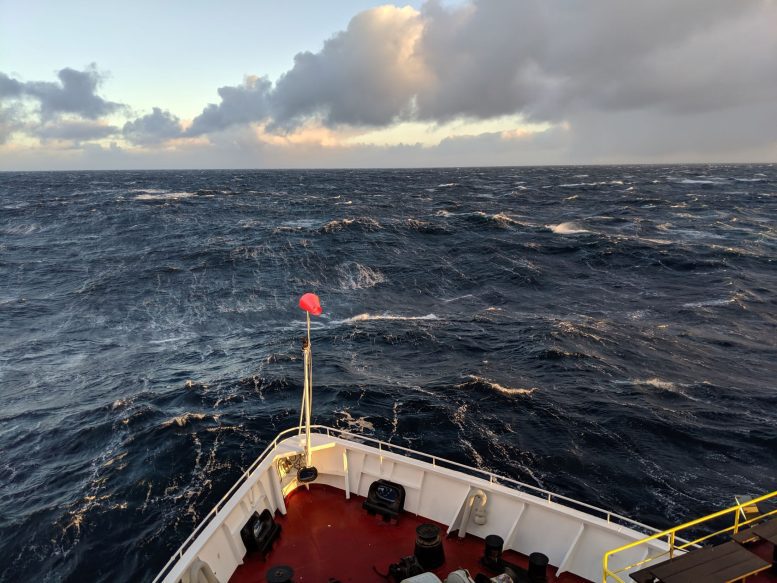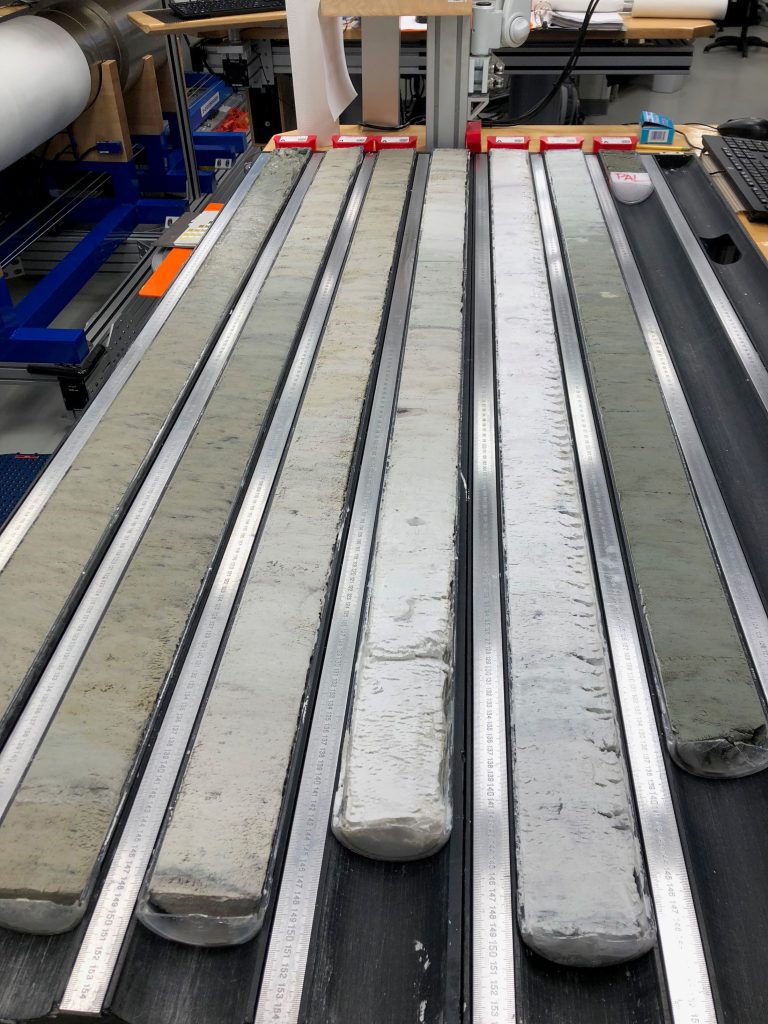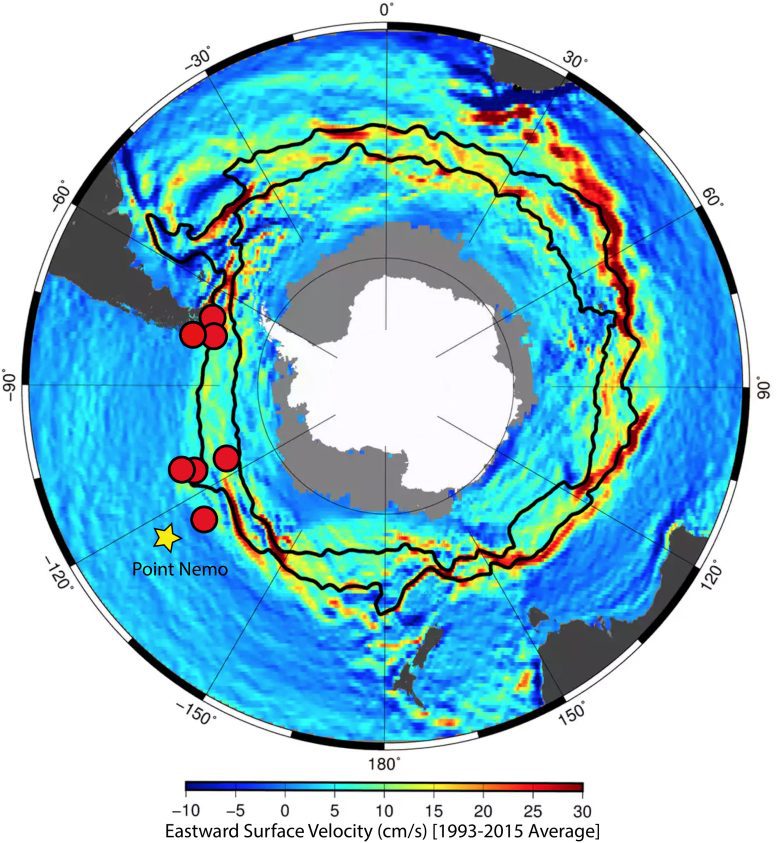
Scientists got a 5.3 million-year history of the Antarctic Circumpolar Current by collecting sediment cores in the Earth’s most remote waters.
The Antarctic Circumpolar Current has sped up before, and recent discoveries show that it's happening again.
It moves more than 100 times as much water as all the world’s rivers combined. It stretches from the ocean’s top to its bottom, and measures as much as 2,000 kilometers across. It links the Indian, Atlantic and Pacific oceans, and has a big role in controlling global climate.
The Antarctic Circumpolar Current, which is the most powerful and important mover of water in the world, is continuously swirling around the southernmost continent. For the past few decades, it has been getting faster, but scientists have been unsure whether this is linked to human-induced global warming, and whether it might counteract or increase some of the effects of warming.
In a new study, an international research team used sediment cores from the roughest and most remote waters on Earth to show the ACC’s relationship to climate over the last 5.3 million years. Their main discovery is that during past natural climate changes, the current has moved along with Earth’s temperature, slowing down when it's cold and speeding up when it's warm―these speedups helped cause major losses of Antarctica’s ice. This indicates that the current speedup will continue with human-induced warming. This could speed up the melting of Antarctica’s ice, raise sea levels, and maybe affect the ocean’s ability to soak up carbon from the air.
The findings were recently published in the journal Nature.
Current Observations and Geological Findings
Study coauthor Gisela Winckler, a geochemist at Columbia University’s Lamont-Doherty Earth Observatory who co-led the sediment sampling expedition, says, “This current is the mightiest and fastest in the world. It is possibly the most important current in the Earth's climate system.” She also said, “The retreat or collapse of Antarctic ice is linked to the increased ACC flow, a scenario we are seeing today because of global warming.”

Fresh sediment cores were collected aboard the drill ship JOIDES Resolution, showing stronger currents during warm times and slower ones during cold. Credit: Gisela Winckler
The Antarctic Circumpolar Current started about 34 million years ago, after forces separated Antarctica from other land masses further north and the ice sheets began forming; the current is believed to have started flowing in its modern form 12 million to 14 million years ago. Fueled by constant westerly winds, and with no land in the way, it circles Antarctica clockwise at about 4 kilometers (2.5 miles) per hour, carrying 165 to 182 million cubic meters of water each second.
Scientists have noticed that winds over the Southern Ocean have became 40% stronger over the last 40 years. This has accelerated the Antarctic Circumpolar Current (ACC) and energized large swirling currents within it, pushing warm waters from higher latitudes towards Antarctica's massive floating ice shelves. These warm waters are eroding the undersides of the ice shelves, which is the main reason for their decline, not rising air temperatures, especially in western Antarctica.
If you let an ice cube sit in the air, it takes a long time to melt. But if you put it in contact with warm water, it melts quickly.
The loss of ice can be attributed to increased heat moving towards the south. A stronger ACC means that more warm, deep water reaches the edge of Antarctica's ice shelves, according to Frank Lamy, the lead author of the study from Germany’s Alfred Wegener Institute.

The Antarctic Circumpolar Current, driven by strong winds, moves in a clockwise direction around the southern continent. The hotter colors in the image represent higher currents, with red dots indicating drill sites.
Through a series of processes, the ocean waters surrounding Antarctica currently absorb around 40% of the carbon introduced into the atmosphere by humans. The study involved around 40 scientists from twelve different countries. The researchers conducted their work at sea, aboard the JOIDES Resolution drill ship near Point Nemo, the spot in the far southwestern Pacific that is farthest from land, some 2,600 kilometers from the tiny Pitcairn Islands. The two-month cruise occurred from May to July 2019, during the harsh austral winter with limited daylight and waves reaching heights of 20 meters. The ship's crew lowered a drill string about 3,600 meters from the ocean's surface to the ocean floor. They then drilled through the floor and extracted thin sediment cores measuring between 150 and 200 meters long. Using an advanced X-ray technique, the scientists analyzed layers formed over millions of years, allowing them to track numerous changes in the speed of the ACC over time. Comparing the current flow to the average over the last 12,000 years, they found that flows decreased by as much as half during cold periods and nearly doubled during warm periods.
earlier research on the West Antarctic Ice Sheet indicated that periods of fast ice movement corresponded to repeated ice retreats, which were followed by cooler periods when glaciers advanced. The warmest extended period in the 5.3-million-year old record was during the Pliocene, which ended around 2.4 million years ago. This was followed by a period known as the Pleistocene, during which numerous cold glacial periods alternated with warmer interglacial periods, causing the current to speed up and the ice to retreat. Much of the West Antarctic Ice Sheet is currently attached to land that is below sea level, making it highly vulnerable to invasion by warm ocean waters. If the ice were to melt completely, global sea levels would rise by approximately 190 feet.
The researchers state in their paper that these discoveries provide geological evidence supporting the idea that the flow of Antarctic Circumpolar Current (ACC) will increase even more as the global temperature continues to rise. They also suggest that if this is true, the increase in ACC flow with a warmer climate would follow the pattern seen in historical records and likely have negative effects.
The Antarctic Circumpolar Current has sped up in the past, and recent discoveries confirm that it is happening again. It carries more than 100 times as much water as all…
Reference: “Five million years of Antarctic Circumpolar Current strength variability” by Frank Lamy, Gisela Winckler, Helge W. Arz, Jesse R. Farmer, Julia Gottschalk, Lester Lembke-Jene, Jennifer L. Middleton, Michèlle van der Does, Ralf Tiedemann, Carlos Alvarez Zarikian, Chandranath Basak, Anieke Brombacher, Levin Dumm, Oliver M. Esper, Lisa C. Herbert, Shinya Iwasaki, Gaston Kreps, Vera J. Lawson, Li Lo, Elisa Malinverno, Alfredo Martinez-Garcia, Elisabeth Michel, Simone Moretti, Christopher M. Moy, Ana Christina Ravelo, Christina R. Riesselman, Mariem Saavedra-Pellitero, Henrik Sadatzki, Inah Seo, Raj K. Singh, Rebecca A. Smith, Alexandre L. Souza, Joseph S. Stoner, Maria Toyos, Igor M. Venancio P. de Oliveira, Sui Wan, Shuzhuang Wu and Xiangyu Zhao, 27 March 2024, Nature.
DOI: 10.1038/s41586-024-07143-3



